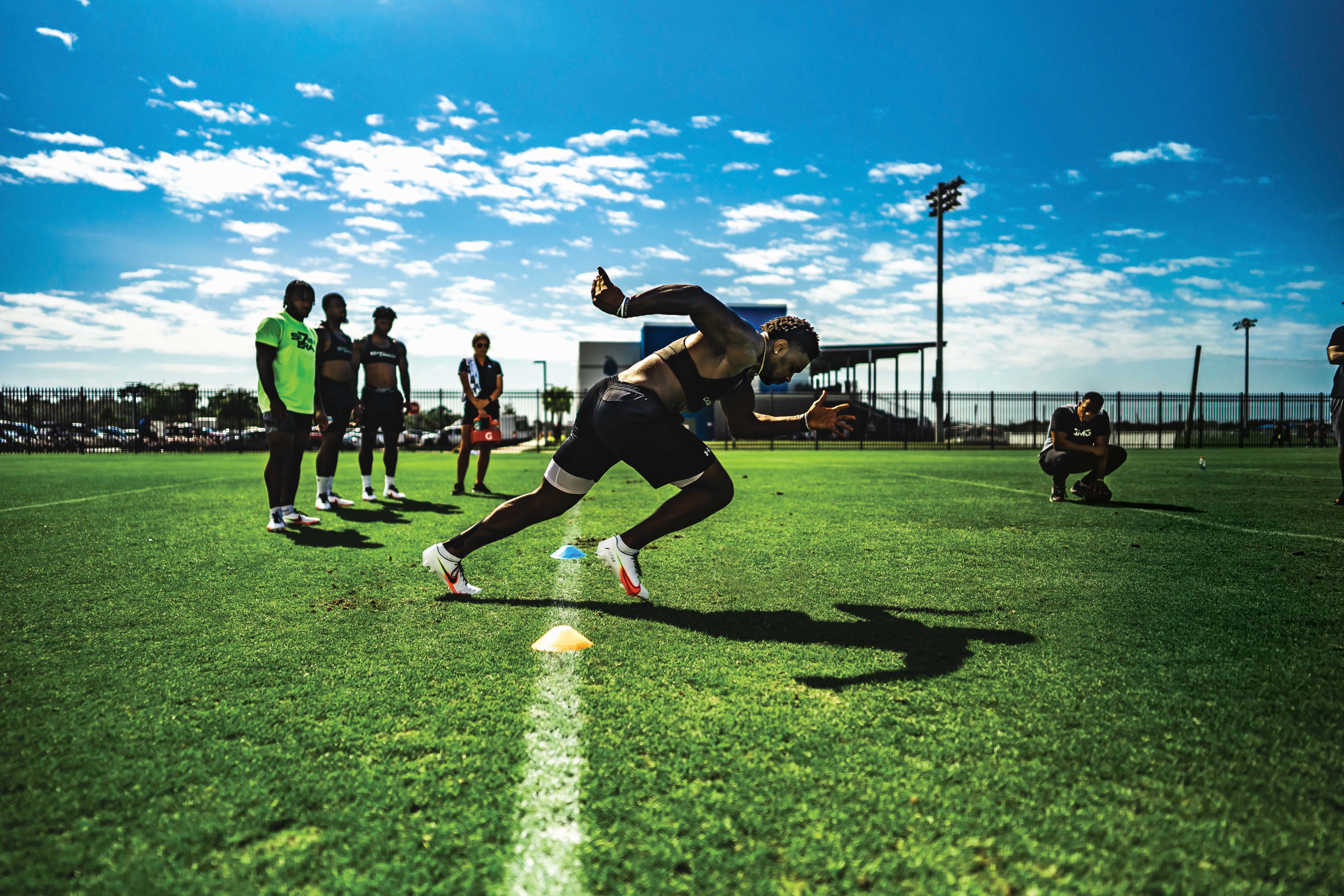
Every Year, Elite College Football Players Descend on IMG Academy
Sheer numbers reveal the audacity of the ambition: In 2019, more than 1 million boys and 2,400 girls in the United States played high school football. Only about 10,000 of those players will earn scholarships to play for a major college. And, when the National Football League conducts its annual seven-round draft, just 224 players out of that vast pool of dreamers will hear their names called.
K.J. Osborn expects to be one of them. But even though the 5-foot-11, 203-pound wide receiver has dominated on the football field since he was a child and caught 50 passes and scored five touchdowns last season in a starring role for the University of Miami Hurricanes, Osborn is taking nothing for granted. Which is why he, or more precisely, his agent, paid nearly $18,000 to install him for two months this winter at the IMG Academy in Bradenton.
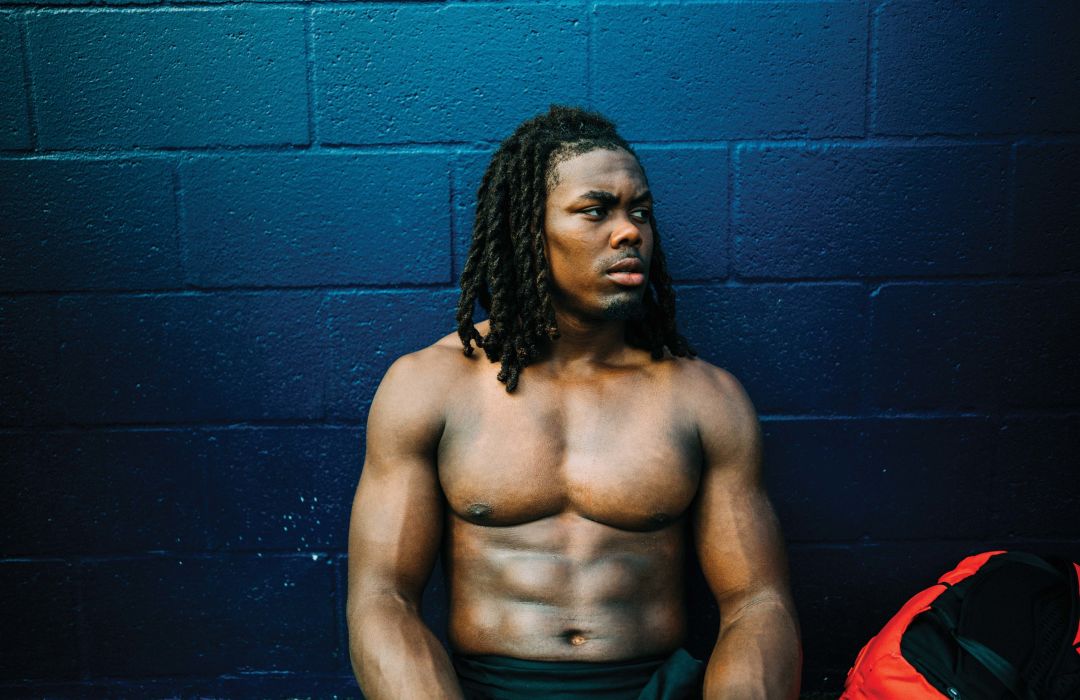
University of Miami receiver K.J. Osborn rests after a speed workout. After two months of IMG training, he’s ready to show the NFL what he’s got.
Image: Everett Dennison
Osborn, who has eight-pack abs and guns for biceps, was lining up on an IMG practice field on an overcast morning in late February to run through a gauntlet of tripod-mounted laser timing devices in the quest to get a blink-of-an-eye faster. His goal is to shave two- or three-tenths of a second off his time in the 40-yard dash, which could vault him into the upper rounds of the draft and make him a wealthy young man.
Osborn and five other pro prospects are surrounded on the field by IMG coaches and trainers, led by a small man with a towel over his head who never even played college football. He is Mo Wells, a former track star, who is IMG’s speed coach.
“It may not seem fair, but the hard truth is that how fast these guys run when they work out [for NFL scouts] can trump what they did for four or five years with their college teams,” Wells says. “On average, I can help these guys take between two- to four-tenths of a second off their 40 time, which can be the difference in getting drafted or not.”
Speed work is only part of what IMG does to prepare players for the NFL draft, which takes place April 23-25. Six days a week, players focus on strength training, nutrition, leadership and test taking. The academy even has a “mind gym,” in which players sharpen their neuro-processing abilities with video games and puzzles, some modeled on the programs used by Air Force fighter pilots.
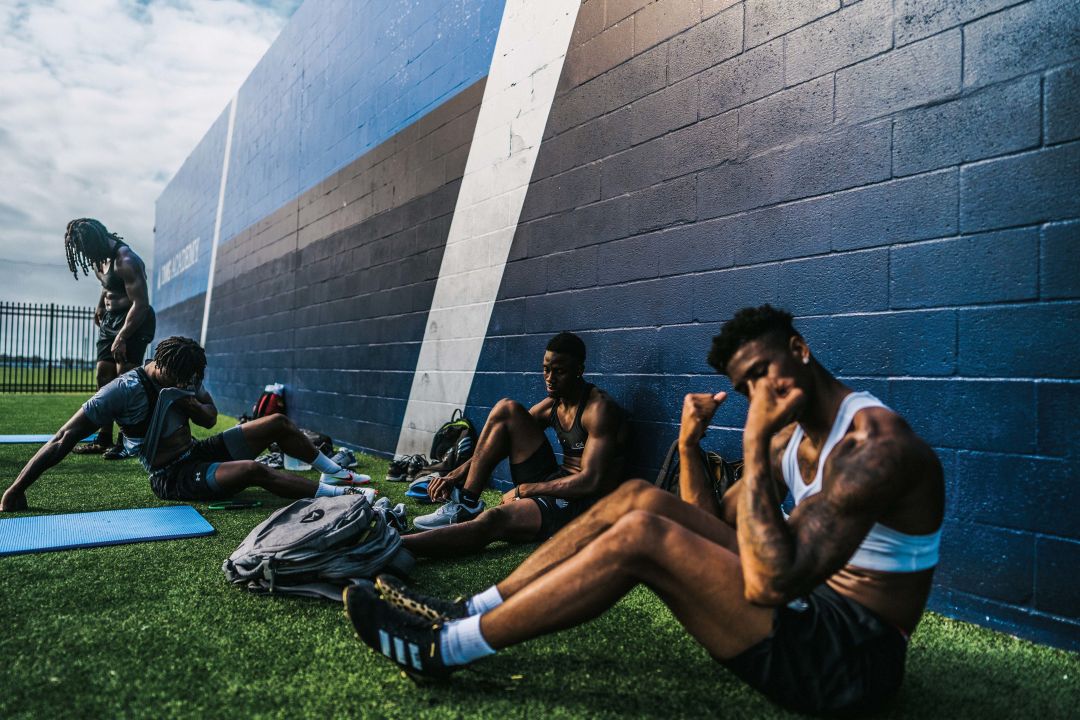
Limbering up before training
Image: Everett Dennison
Another major part of the IMG program is rehabilitation from the toll years of playing football takes on the body. A 2017 study by a Stanford University researcher found that the physical trauma of playing a single college football game was equivalent to that sustained from being in a car going 30 miles an hour that crashed 10 times into a concrete wall. At IMG, players spend hours restoring their bodies in a massive training complex that includes ice baths, hyperbaric chambers, a yoga studio and physical therapy.
IMG this year limited enrollment in its NFL draft preparation program to 20 players—all top talents, such as running back D’Andre Swift, a star for Georgia; Michigan’s prolific quarterback Shea Patterson; and six members of Louisiana State’s national championship team. All the players were working toward the fateful weeks before the actual draft, when NFL coaches, scouts and executives scrutinize players from head to toe at a national combine and, later, in smaller “pro days” at college campuses.
At the combine, players are tested for speed, strength (how many times they can bench press 225 pounds; short answer: a lot), jumping and agility. They are poked, prodded and scanned for injuries that many played with in college but never made public. They undergo the Wonderlic test (answer 50 questions in 12 minutes) to determine their mental acuity. They are psychologically analyzed and
anatomically measured. Such is the scrutiny that even the size of a player’s hands can become a national story: This year, Heisman Trophy-winning quarterback Joe Burrow’s hands measured only 9 inches, leading Burrow to sarcastically post on Twitter that his career was over. (He’s still expected to be a top pick.)
“These players are facing what’s known as the world’s toughest job interview,” says Taryn Morgan, who heads IMG’s draft preparation program and who has a doctorate degree in sports psychology. “Our job is to prepare them for it, and our theme is, ‘Prepared to dominate.’”
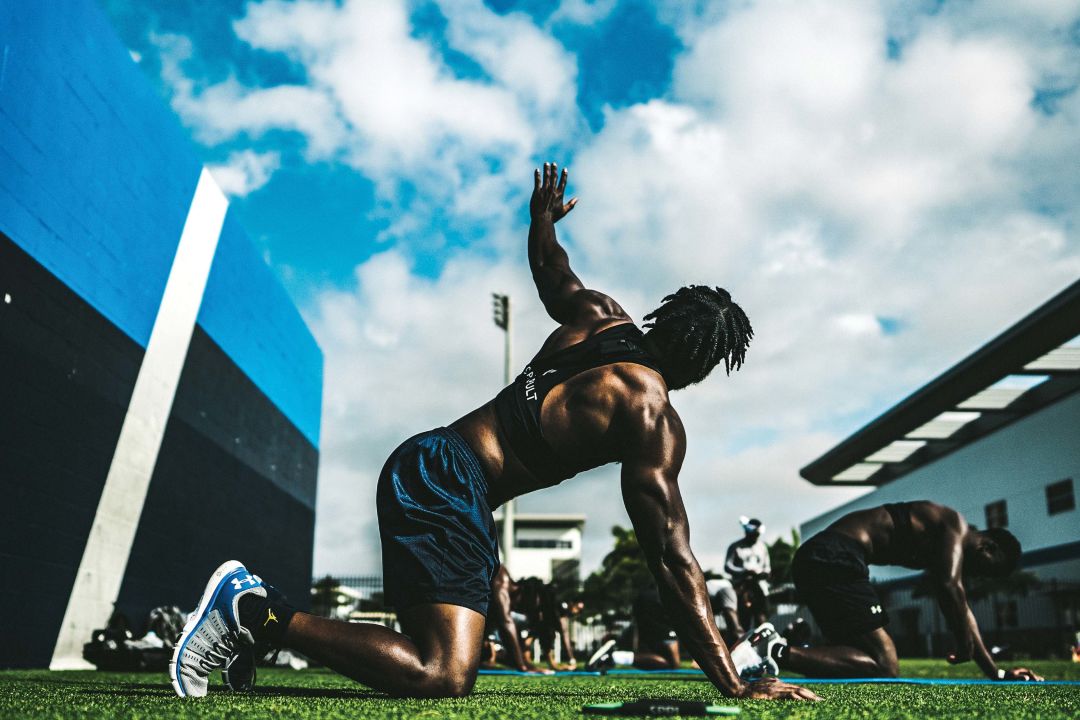
Stretching the spine before a workout.
Image: Everett Dennison
IMG’s Star Power
Born on Longboat Key in 1978 when Nick Bollettieri started the nation’s first tennis boarding academy, IMG Academy now occupies close to 600 acres in west Bradenton, training athletes from childhood to seniors across the sporting pantheon, from lacrosse to golf, from tennis to basketball. Its training facilities, which rival or surpass many major colleges, include more than 20 sports fields, a 5,000-seat stadium, an 18-hole golf course, two 10,000-square-foot weight training rooms and the Gatorade Sports Science Institute, as well as academic classrooms, an on-campus hotel and dormitory villas that house hundreds of young athletes. (A year’s tuition, room and board for these youngsters starts at nearly $57,000 and climbs depending on the athlete’s program. So many kids fly in on private jets that their parents remark they have trouble finding room at the airport to park their planes.)
IMG started its NFL draft preparation program in the 1990s and has attracted such future stars as Drew Brees, Eli Manning and Russell Wilson. With competition to reach the NFL becoming fiercer by the year, players eyeing the draft now routinely leave school after the first semester of their senior year (or earlier), signing with an agent who typically bankrolls their training. IMG offers an especially attractive destination, not just because of its elite trainers and facilities, but also because, well, who wouldn’t want to train near the beach?
“They’re focused on you and only a few other players here,” says A.J. Green, a cornerback from Oklahoma State, taking a break in the IMG weight room. “In college, they’re focused on 100 or more guys, putting a winning team together. Here, they’re focused on everything to help me get drafted, from nutrition to speed work. And the goal is to have me peak at just the right time.”
Of all the pre-draft tests, none loom larger than the NFL draft combine, which takes places over four days in Indianapolis during the last week of February. Only 330 players are invited; and this year, 16 of them came from the 20-man group training at IMG.
Morgan, whose official title at IMG is director of Athletic and Personal Development, says that while the physical tests, such as the 40-yard dash and the bench press, get most of the attention, the vast majority of the combine is devoted to medical tests, psychological evaluations and interviews.
“The physical testing doesn’t happen until the final day at the combine,” Morgan says. “Our job is to prepare them for multiple days, hour after hour, of the medical aspect, the psych aspect, the interviews in front of NFL coaches, scouts and even team owners. We work with them to be themselves, and, if they have had any challenges, to be honest and direct. We don’t want them to be robots.
“From a holistic approach, I think this is the best program we do,” Morgan continues, “because we work on every aspect of personal development, including nutrition. We have former NFL coaches come in to talk about what players should expect, not just in the draft, but getting through rookie camp and their first season. Our goal is not just to help them reach the NFL, it’s to get them that NFL contract, where the real money is made these days.”
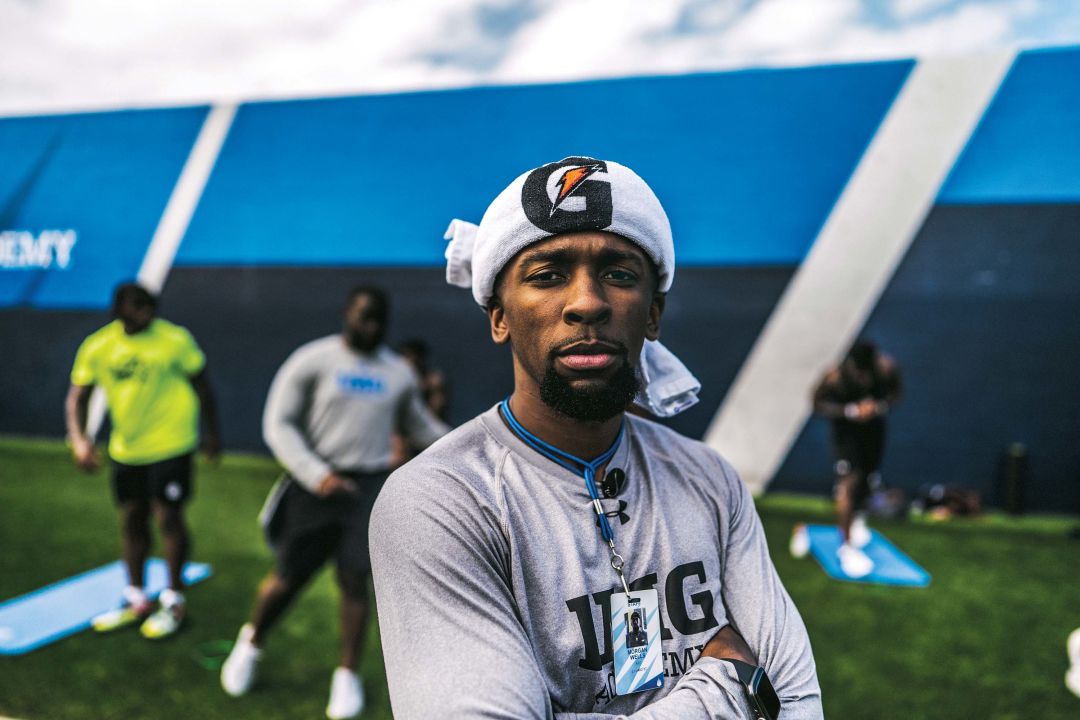
Mo Wells, IMG’s speed and agility coach.
Image: Everett Dennison
After two months of preparation, K.J. Osborn, the former Miami star, said he was ready to show the NFL what he’s got. Osborn can bench press 365 pounds and squat more than 500 pounds, so he knows he is one of the strongest receivers. Now, thanks to the training he received from speed coach Wells, Osborn was confident he could post an eye-catching time in the 40-yard dash. The training program, he said, has also helped him make large strides in the mental part of the game, including his reaction times.
“Your brain is a muscle, your most important muscle, and I’ve been working mine out here every day, just like the rest of my body,” Osborn says. “I’ll lay in bed at night and do mental exercises, just trying to get a little sharper, a little better, to help me take this next step and get to the NFL.”
The training paid off: Osborn clocked 4:48 seconds in the 40-yard dash at the combine, meaning his speed is no longer a question for scouts, and his dream of playing in the NFL is closer to being realized.